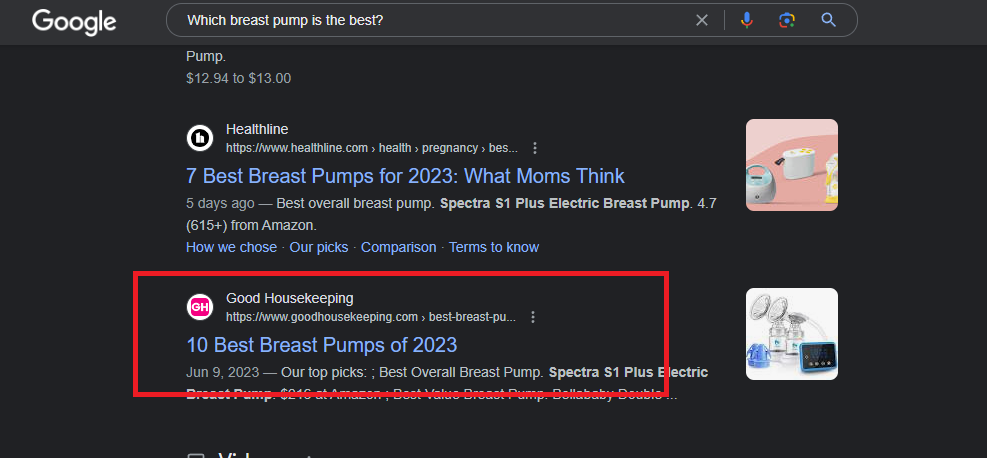There are hundreds of ways to do affiliate marketing, but to carry out an effective and sustainable affiliate marketing campaign, you need to focus on the following important ways:
Building a website/blog and doing SEO
Review
This is a type of website/blog specializing in providing product reviews.
This type of website often delivers the most value to users, and that's why the best-performing affiliate marketing sites are mostly review sites.
Simply put, users always want to find credible reviews before making a purchasing decision. They want to see what others have to say about the product they're considering, the product's quality, and its price.
For example, a mother who is nursing a baby and is about to buy a breast pump:
She could go straight to e-commerce websites to make a purchase... but usually, she won't! Because she knows that there are many types of breast pumps available. So, she will perform a search.
What is she searching for?
She's searching for the things that matter most to her: Which breast pump is the best? (Because her top priority is the safety of her child)
So, how do you approach her? You need to appear on the Google search results for the keywords she's using, keywords that accurately reflect her top concerns.
And then, you guide her to a detailed article about how to choose a breast pump, which type is the best, what the prices are like, and of course, where to buy (with your affiliate marketing links attached).
With this approach, you might invest a lot of time and effort, and results might come slowly, but in the end, this is the most sustainable method, and once it yields results, those results can be substantial.

Price Comparison Website
With this type of website, your focus will be on providing users with the highest benefit: Where to buy a product at the best price?
With this kind of website, you'll spend less time because most of the price comparison functions are performed by tools.
However, the question to ask is: I've created a price comparison website, but how do I get visitors to come and perform price comparisons?
This is the real challenge!
Because even if you have a modern price comparison website, if nobody knows about it and nobody visits it, i.e., you have zero traffic, then ultimately your results will be zero.
So, the answer remains: What strategy are you using to attract traffic?
Creating content and providing value through articles?
Or investing money in marketing (advertising)?
It depends on your resources and capabilities!
For a price comparison website, you will need to invest a significant budget. The budget here includes the initial budget for the technical part (price comparison), and then the budget for marketing (creating content and advertising to attract traffic).
With a price comparison website, if you do it well and have good, stable traffic, you can generate significant income from affiliate marketing. However, it's not easy in practice because there are already many price comparison websites that dominate Google search results.
If you are determined, have the resources, and have the budget, then this can be a viable option for you.

Coupon Code Website
This is the most competitive type of website, but it's also likely to lead to the most failures and dropouts.
Saying this doesn't mean there's no way for you to start a coupon code-sharing website.
The issue is how you think about it and how you approach this model.
If you simply think that creating a website/blog and adding coupon codes, then waiting for users to visit and click the "coupon code" button to trigger the affiliate marketing link, then you can continue... waiting!
It's never that simple!
In summary, to succeed with a coupon code website, you need to know how to create content, generate traffic, market effectively, and sometimes even invest in buying traffic (advertising).

Cashback Website
The cashback model is currently thriving in the world of online shopping and is being heavily invested in by many large companies. (This model is less commonly pursued by individuals.)
In essence, cashback websites still generate income from affiliate marketing, but they attract users by offering cashback when they make purchases through their website.
In summary, this is an intermediary website model that targets frequent online shoppers. It's more convenient than coupon codes because cashback websites don't have to search for and update coupon codes regularly.
Customers feel they are getting a good deal when they not only find a discounted product but also receive cashback directly on the cashback website. They can withdraw this money or use it for future online purchases.
Developing a cashback site is not easy, as it involves some technical aspects that need to be addressed. This model also requires various marketing strategies and financial and human resources investment.

In conclusion, among the affiliate marketing methods above, building a product/service review website is the simplest and most accessible for individuals. It can be said to be highly effective and sustainable. However, the key to success with this approach lies in delivering high-value content and implementing a robust SEO (search engine optimization) strategy to attract traffic. Once the website owner (affiliate marketer) understands the essence of affiliate marketing, the needs of customers, and prioritizes providing high-value content, success in affiliate marketing becomes entirely achievable.
Running Social Media Ads to Make Money with Affiliate Marketing
Currently, this is the most commonly used method. However, we need to assess its effectiveness.
Typically, Facebook is the platform that many people use for running affiliate marketing ads. It's simple, all you need is one fan page, one credit card, and a few steps to advertise to your target audience.

In the image above, you can see a fan page focusing on the female audience. They have undoubtedly previously shared content related to this target audience and, once they've attracted a large amount of engagement and followers, they can start running ads to earn money through affiliate marketing.
Becoming a Social Media Influencer / content creator
Using Facebook for Affiliate Marketing: This is also a way to do affiliate marketing (and more). Many people choose to become Key Opinion Leaders (KOLs) who are highly active on social networks. When they have a large following, they can share valuable information related to a product/service and attach an affiliate marketing link or a sponsored link (a paid link).
On Instagram, you can also find affiliate marketing advertisements or affiliate links placed in the bio section.
Using YouTube for Affiliate Marketing: The trend of watching product review videos on YouTube is significant, making it an opportunity for many to engage in affiliate marketing by sharing their own videos.
This method is suitable for individuals who have good communication skills and feel confident speaking in front of the camera. Creating a YouTube channel is straightforward, and anyone can start. With a smartphone capable of recording videos, you can begin affiliate marketing on YouTube.
The key is to include affiliate marketing links in the video description and use call-to-action prompts to encourage viewers to click on the links below to purchase products.
This method is relatively simple, and anyone can start immediately. However, it requires a considerable investment because most product review videos will require you to have the actual products. To obtain these products, you'll likely need to purchase them.
Doing Affiliate Marketing on TikTok: TikTok is a popular short-video social network that many people are interested in. You can also utilize TikTok for effective affiliate marketing.
As an example, a TikTok channel specializing in reviewing household products, cosmetics, food, or pet accessories. You can create short review videos on your TikTok channel. Then, use the link placement technique in your TikTok bio so that viewers can click on it, and when they make a purchase, you'll earn a commission.


When it comes to using social media for affiliate marketing, many people are already applying these strategies, and it's undoubtedly an essential part of affiliate marketing strategies as a whole.
Of course, the choice of which social network to use and the strategy to employ depends on each individual's suitability and the specific products or industries you choose for affiliate marketing.
For example, if you select the technology niche for affiliate marketing and want to use social media, then YouTube would likely be a top choice. If you have a passion for fashion and beauty and you're marketing within those industries, then Facebook and Instagram might be the platforms where you need to be more active.
How to combine all these methods into an ecosystem?
In the discussion above, you've seen various affiliate marketing methods. Now, let's explore how to combine all these approaches into a cohesive system.
In reality, when we refer to an "affiliate marketing ecosystem," it can be a bit challenging to grasp. We can call it an affiliate marketing system, which might be more accurate.
In this system, a website/blog remains at the center. It's where you can "channel" traffic from various sources such as Facebook, YouTube, Instagram, and more.
At the core, you need to establish a data collection system (customer data), and the leading solution for this is still Email Marketing.
This means that you can promote and share content on your fan page, run Google ads, create videos on YouTube, write and share content in various groups, but ultimately, your goal is to "direct traffic" to your website.
Once visitors are on your website/blog, you need to attract them to subscribe to your email list (i.e., you're collecting customer data) and encourage them to return to your website/blog through email marketing activities.
This is the approach to combine and integrate all platforms and models into a system of your own. Undoubtedly, this is the way to turn affiliate marketing into a full-fledged profession for yourself.
For more information, you can refer to:
